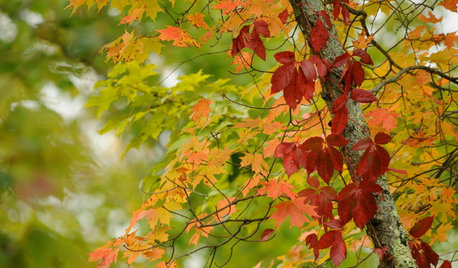brown appearing on brandywine leaves
corpus
9 years ago
Related Stories

FALL GARDENING5 Ways to Put Fall Leaves to Work in Your Garden
Improve your soil and yard the organic way with a valuable garden booster that grows on trees
Full Story
REMODELING GUIDESInterior Brick: Paint it or Leave It?
Here's how to know if covering that brick is a sin or solution
Full Story
COLORFall on the Wall: Decorating With Rich Reds, Browns and Oranges
For your interiors, take a cue from nature’s colorful seasonal offerings
Full Story
DECORATING GUIDESInspired by Fall: Reds, Oranges and Browns at Home
Add just an accent or rake in the color with shades of autumn all over the house
Full Story
GARDENING GUIDESGot Frost-Damaged Plants? How It Happens, and When and How to Prune
Crispy brown leaves are a sure sign that Jack Frost has been to your neighborhood
Full Story
FALL GARDENINGHouzz Call: Show Us Your Fall Color!
Post pictures of your fall landscape — plants, leaves, wildlife — in the Comments section. Your photo could appear in an upcoming article
Full Story
CURB APPEALWhen to Paint Your House Brown
Nature loves brown, from rich soil to sunlit sand, and so do home exteriors with a traditional or Craftsman bent
Full Story
COLORHow to Use Marsala, Pantone’s 2015 Color of the Year
Pantone digs deep and goes earthy with its selection. Here are ways to make it work in your home
Full Story
BEFORE AND AFTERSA ‘Brady Bunch’ Kitchen Overhaul for Less Than $25,000
Homeowners say goodbye to avocado-colored appliances and orange-brown cabinets and hello to a bright new way of cooking
Full Story
GARDENING GUIDESGarden-Friendly Native Alternatives to Overplanted Exotics
There are lots of gorgeous, wildlife-friendly native plants ready to make an appearance in your garden
Full Story






seysonn
corpusOriginal Author
Related Professionals
Lowell Landscape Architects & Landscape Designers · East Patchogue Landscape Architects & Landscape Designers · Tempe Landscape Contractors · Waterbury Landscape Contractors · Bristol Landscape Contractors · Concord Landscape Contractors · Golden Landscape Contractors · Longmont Landscape Contractors · Nanuet Landscape Contractors · Olympia Landscape Contractors · Ringwood Landscape Contractors · Lauderdale Lakes Landscape Contractors · Erlanger General Contractors · Jericho Stone, Pavers & Concrete · Del City Decks, Patios & Outdoor EnclosuresPupillaCharites
seysonn
seysonn
jean001a
PupillaCharites
corpusOriginal Author
corpusOriginal Author
PupillaCharites
corpusOriginal Author
PupillaCharites
corpusOriginal Author
jean001a
PupillaCharites
corpusOriginal Author